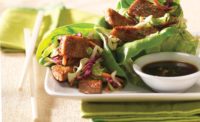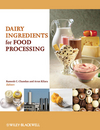Dairy Analogs
You might call them “dairy deceptions.” Dairy analogs made from soy, grains, nuts, coconut, seeds -- and even algae -- work hard to fool lovers of milk, cheese, yogurt and frozen treats.


Soy is an ingredient among the more ancient substitutes for dairy, providing the balance of fat, protein and carbohydrate, with textural versatility, to match that of real dairy products.
SOURCE: THE SOYFOODS COUNCIL

A new European milk substitute made from organic corn takes advantage of the silky smoothness of its cornstarch.
SOURCE: LAVENEZIANE/MOLINO DI FERRO SPA

Starch-derived systems for dairy mimics allow for developing ever-more authentic reproduction of traits of meltability, firmness and sliceability, as well as shredding and gratability in non-dairy cheeses.
SOURCE: FOLLOW YOUR HEART CO.




The reasons for divesting the diet of dairy can be multifold. The most common drive to go dairy-free is lactose sensitivity/intolerance. If an aversion to lactose seems to be more prominent today, its suddenness on the American scene is not necessarily due to some “free from” trend or bandwagon health fad, but rather demographic coincidence.
The Europeans who flooded the U.S. in the first few hundred years were predominantly those who had the genetic ability to digest cow’s milk—the British, Irish and Northern Europeans. But, they actually are in somewhat of a minority for that trait.
In many of the world’s populations, difficulty in producing lactase, the enzyme that digests the milk sugar lactose, can affect up to 80% or more of the population. Asians and Africans typically have the highest rates of this condition, but up to 50% or more of Hispanics, Southern Mediterraneans, Jews, Native Americans and Middle Easterners can have trouble digesting dairy. And, those are the ethnic groups most welcomed by the United States during the 20th and 21st centuries.
Other reasons for saying “no” to milk and cheese can be due to allergies, such as to the dairy milk protein casein, or related to trends, i.e., the strong growth in vegetarianism. This is especially true of veganism, the form of vegetarianism that shuns all animal-derived products. And, for some, it is driven by calorie or cholesterol restrictions, since many (but not all) milk substitutes have fewer calories than their dairy milk equivalent and are, by nature, cholesterol-free.
Finally, religious considerations have played a significant hand in the development of non-dairy alternatives to milk, cream, ice cream and other traditionally dairy-inclusive ingredients -- think pizza and enchiladas, etc. The laws of kashrut – kosher -- not only forbid the combining of meat and dairy, they demand a gap of up to six hours between the consumption of meat and partaking of dairy.
Tofutti Brands Inc. CEO and founder David Mintz created an expansive line of soy-based, dairy-free products initially to satisfy this niche. Yet, found such success with the other non-dairy demographics that, 32 years after its start, the company annually racks up net sales in the eight figures.
Four-part Harmony
When it comes to liquid milk analogs, the goal is to replicate the fundamental components of the juice of the cow (or goat or sheep) as much as the taste. Milk is, essentially, an emulsion of water, fat, carbohydrates and protein. Vitamins, minerals and other micronutrients are suspended therein, but the four main ingredients are what hold milk together.
Certainly the most common of dairy alternatives is soy milk. With brands like Silk, Edensoy and Soy Dream elbowing in on dairy milk’s consumer base, the once-fringe beverage could not be more mainstream. Rice milk, too, has been a long-time player in the field. Although almond milk entered the American pantry later than soy and rice, it did so on the back of centuries of tradition, having been used in the Middle East and Europe since at least the Middle Ages.
The past few years have seen a rush of mock milk products made from other nuts (i.e., hazelnuts, cashews); legumes (in addition to soy, some manufacturers have test-marketed milk from peanuts and peas); seeds (such as sunflower, hemp, flax and chia); and grains.
The nuts (including coconuts), seeds and legumes have the fat content; the grains rice, quinoa, kamut, amaranth, millet, oats and others have the carbohydrate content for sweetness and binding. Oats, especially, have higher amounts of carbohydrates in the form of gums, which increase viscosity and binding in formulation, although higher heat of cooking causes them to overshoot the mark and become gelatinous.
One new milk substitute recently released in Europe and only just making its way here uses corn. Cornstarch has been used for decades as a thickener, binder and texturant because of its incredible silkiness. This begs the question as to why it’s such a latecomer to the field.
The product, made from only a few ingredients -- water and organic cornmeal, sunflower oil and a pinch of salt -- can readily compete with the other grain-based milk substitutes for texture and drinkability. Its caloric content is slightly higher than fluid dairy milk, at about 150 kcals per cup, and -- while there is a slight, sweet corn taste to it -- in some applications this can be a benefit, as it needs no maskers.
From Nuts to Milk
Cheese analog manufacturers have been steadily perfecting their products’ organoleptic and functional capacities; the majority of cheese substitutes are used as replacers in products that are a part of a prepared formulation -- often cooked -- and so are enjoyed in conjunction with multiple companion ingredients.
Milk mimics, however, most often must stand on their own when it comes to flavor, mouthfeel and texture. This means they must strike the right balance between maintaining the positive characteristics of their individual source.
“All milk products are emulsions, and those that are most complete are animal-based,” says John Csukor, president and CEO of KOR Food Innovation Inc., on behalf of the Almond Board of California. “One of the greatest challenges in creating non-dairy milk analogs is that consumers have had the flavor of milk defined already. There is a naturally occurring texture, a distinct flavor and an overall satisfying quality to dairy milk that consumers already are comfortable with.”
The search for a perfect base ingredient to create a milk substitute, according to Csukor, must have the following characteristics: an equivalent or similar nutritional balance of dairy milk; a natural sweetness to avoid added sweeteners to make it palatable; and a balance of sweetness, neutrality and richness that can allow it to take on other flavors when used in formulations.
“The ideal is to create a perfect balance of nutrients, water and fat. Most successful vegetal milk analogs are best when the levels of ingredients most closely match that of dairy milk.” As Csukor describes, all milk-like beverages have an inherent, natural separation that needs to be corrected. He points to replicating the process of homogenization as a “great start to solidifying the emulsion in nut milk products.”
“A few techniques clearly rise above others in creating a more robust and stable mixture,” explains Csukor. “One is to increase protein and fat solids in a non-dairy milk to make the product more stable. The second involves high-temperature treatment of nut milk. This causes the carbohydrates to set and activates the pectic substances, so that they thicken and stay stable.”
Csukor contributes that high-temperature treatment also aides in longer-term stabilization of nut milks for more expanded uses in the kitchen vs. simple drinkable consumption.
Another measure Csukor points to is to add very low percentages of a stabilizer such as gum. “This a favorite process,” he says, “as it is a relatively low-cost method to extend stabilization instead of using increased solids.”
Coconuts have certainly taken the food and beverage world by storm. Just a few short years have seen coconut-based milk, cheese, margarine spreads, puddings, yogurts, frozen desserts, sour cream analogs and other products. What makes coconut especially adept at mimicking dairy is its balance of fat and carbohydrate. Brands like Coconut Dream, So Delicious, Silk and others hit the market with a gusto that brought them instantly to the front of the pack.
Although each milk replica carries its own profile of vitamins, minerals, omega oils and other micronutrients, all milk analogs typically fortify the product with these nutrients. Vitamin D and calcium, especially, must be included to help them compete with dairy milk, which also typically has its natural complement of these nutrients further fortified.
Nice and Cheesy
“It is not difficult to envision analogs of milk, cheese, yogurt, sour cream and even fermented milks from grains, nuts, soy beans and other legumes,” affirms Kantha Shelke, Ph.D., principal at Corvus Blue LLC, a food science and research firm specializing in the science and technology of ingredients. “Advances in starch-processing technologies have gone a long way to enhance the rheological properties and microstructure of imitation dairy.”
Citing cheese as an example, Shelke points out that tofu can be considered the first non-dairy, vegan cheese analog, and that the product originated in Asia at least 500 years ago.
“Tofu can be made to possess even a strong aroma, reminiscent of European mold-ripened cheeses, such as Roquefort, Gorgonzola, Stilton and other blue cheese; or a sift-ripened cheese, like brie or Camembert; or even a cream cheese, such as Neufchatel,” she says. “Depending on the process and other ingredient, the resulting tofu may be firm, hard, soft, crumbly, smooth or creamy and can virtually imitate most of the properties of cheese including texture and spreadability attributes—except for its melting properties.”
Shelke explains that, although the substitution of the dairy cream by vegetable fat increases the adhesiveness and hardness of a cheese analog, it can be made to be “quite smooth and creamy and virtually indistinguishable” from the 100% dairy counterpart.
“In the traditional cheese, the fat is dispersed as very small particles in a uniform protein network, whereas in the analog, the fat globules are present in smaller numbers and have greater diameter and, therefore, do not do as good a job of softening the resulting emulsion,” she says.
Shelke notes, however, that food science has allowed even some melting capacity in such plant-based cheeses: “The addition of as little as 3% by weight of pre-gelatinized starches from maize, waxy-maize, potato, wheat or rice starches can help trap and disperse fat globules in the background protein matrix and create an albeit softer and less cohesive cheese analog that does not quite melt like an original dairy cheese, but can do the trick in dishes like tacos and pizzas.”
Ingredient makers have pitched in by developing low-cost, starch-derived systems (plant proteins typically are less expensive than animal-derived proteins) for dairy mimics. Primary sources include potato, corn, tapioca, waxy corn, sago and other starch media.
The increase in dedicated technological resources some of the large ingredient manufacturers have invested in allow them to work with processors in developing ever more authentic reproductions of traits of meltability, firmness and sliceability, as well as shredding and gratability capacities. They also have developed ingredient systems that can significantly improve new fluid milk replacers in terms of viscosity, creaminess and flow.
The suddenly ubiquitous coconut, with its rich, yet healthful saturated fat, has proven exemplary in crafting a number of dairy analogs, especially frozen desserts, since the richness of the fat lends itself to a creaminess that comes closer than other plant sources to dairy cream when frozen.
However, one of the more popular cheese analog makers, Galaxy Nutritional Foods Inc., also uses coconut.
“GO Veggie! products are made from a variety of ingredients, such as soy, rice and potato maltodextrin, corn starch, as well as coconut oil,” says Jamie Schapiro, one of the GO Veggie! directors. “We use a proprietary blend of these different ingredients to attain the performance -- specifically taste and melt -- of dairy products.”
“This is the trick in creating any no- or low-dairy formulation,” adds Schapiro. “It is very difficult and expensive to do, and as a result, few companies have been able to bring competitive dairy-free products to market for consumers.” The company was one of the first to successfully recreate the correct mouthfeel and creamy-rich texture, as well as the taste, of dairy cream cheese in a dairy-less product. Schapiro notes that the GO Veggie! developers accomplished this by culturing its product “like real cream cheese.”
Softer Touch
In finding that middle ground between a dairy milk analog and a plant-based cheese -- that is, sour cream or yogurt substitutes -- Shelke singles out a particular challenge to processors. “Sour cream analogs and the like should not contain any casein or caseinates, common ingredients used to form a protein foundation in these formulations. However, the taste and textural characteristics of sour cream are easily replicated using the appropriate bacterial cultures and soy milk as the starting material.”
Replication of texture for solid dairy analogs typically involves more starch than for beverages, of course. Flours from tapioca and arrowroot are commonly used in today’s dairy-free cheeses, due to their abilities to dissolve easily and more clearly; plus, they typically hold up better in conjunction with acids, being lower in protein than grain starches.
Starch from roots and tubers also are gluten-free and thicken more quickly and at lower temperatures than many other plant starches, although prolonged heating will cause some root starch formulations to break. However, rice-derived starches -- specifically brown-rice starch -- have proven to have similar versatility.
Gums are other forms of starch critical to the dairy analog process, providing texture and plasticity. carageenan, guar, carob (locust bean), xanthan and acacia are common sources of vegetable gums for the thickening and stabilizing needed for replicating textures of dairy ingredients. They provide the “toothsomeness” -- shear properties -- for the denser analogs, like cheese, and the creaminess for mock creams and frozen novelties.
Gums and starches also enhance the cohesiveness and fluidity of some of the milk substitutes, effectively replacing the carbohydrates normally present in dairy milk, i.e., lactose and its monosaccharide components, glucose and galactose, as well as some medium-chain saccharides. Inulin is one of many starch ingredients that has done an effective job filling in for the latter in some milk substitute formulations.
Shelke adds that the appearance of non-dairy sour cream will not necessarily appear as white as that from dairy, as dairy sour cream owes its whiteness to the naturally small particle size of fat dispersed throughout the raw material.
“When milks are extracted from soy and other botanical sources, such as nuts and grains, the raw material structure is disrupted, and the fat particles do not disperse as well as they do in milk, and therefore, do not have the associated whiteness,” Shelke states.
Soy is an ingredient among the more ancient substitutes for dairy, providing the balance of fat, protein and carbohydrate, with textural versatility, to match that of real dairy products.
Let’s Get Small!
An exciting, new fluid milk substitute coming to market sometime this year is derived from microalgae, those lipid-rich, single-cell plants being used to produce omega oils, proteins, enzymes, peptides and antioxidants—such as astazanthin.
Derived from whole algal flour, which has been recently applied to use as a dairy and egg substitute in baking, the vegan, non-GMO product is free of known allergens and provides a natural silky/creamy mouthfeel. It is free of trans fats and cholesterol, and high in heart-healthy monosaturated fatty acids. It also is high in protein and fiber, and naturally slightly sweet. Best of all, it needs no flavor maskers.
Looking for a reprint of this article?
From high-res PDFs to custom plaques, order your copy today!












